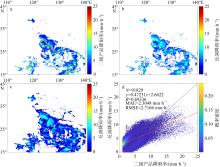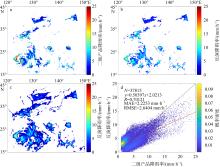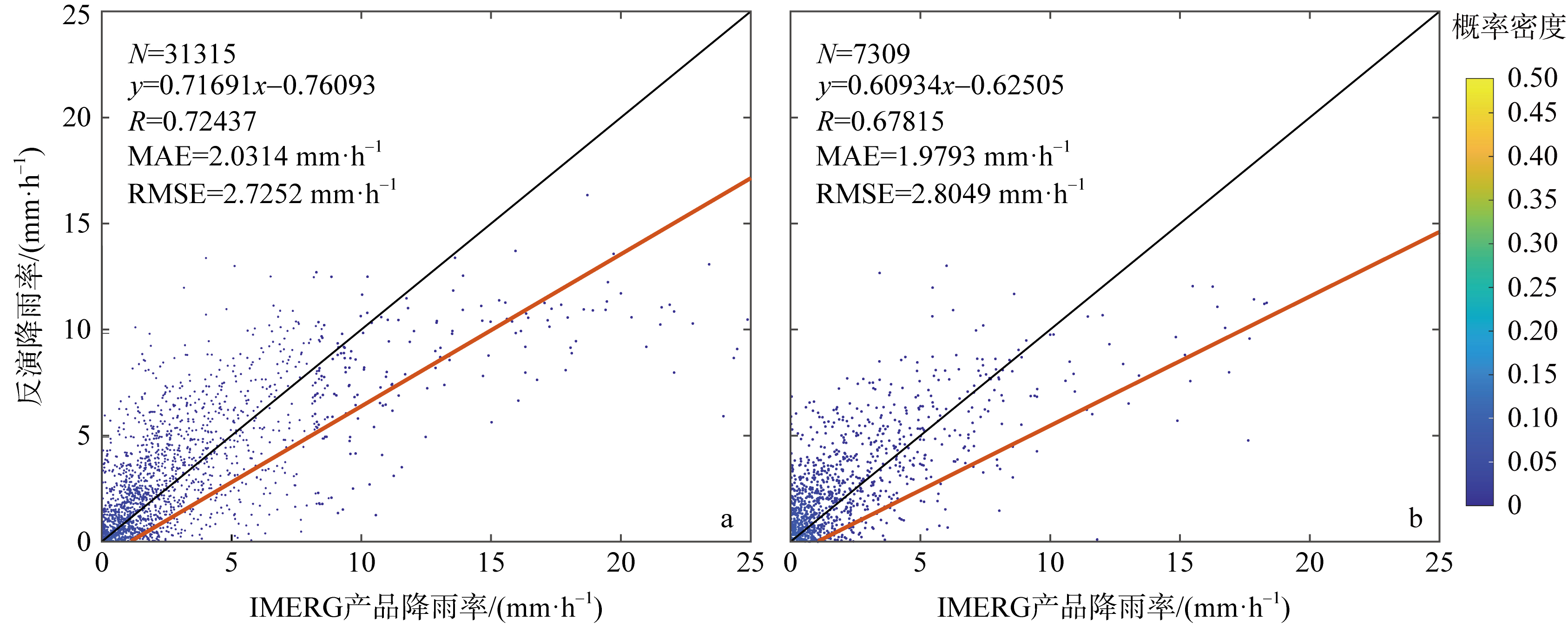| [1] |
邓欣柔, 吴莹, 2022. 基于GPM探测资料的台风降水水平结构分析[J]. 地球物理学进展, 37(5): 1799-1806.
|
|
DENG XINROU, WU YING, 2022. Analysis of horizontal precipitation structure of typhoon area based on GPM detection data[J]. Progress in Geophysics, 37(5): 1799-1806 (in Chinese with English abstract).
|
| [2] |
高娜, 赵明利, 马毅, 等, 2023. 台风对珠江口风暴增水的影响分析[J]. 热带海洋学报, 42(1): 32-42.
doi: 10.11978/2021145
|
|
GAO NA, ZHAO MINGLI, MA YI, et al, 2023. Effect of typhoon on storm surge in the Pearl River Estuary[J]. Journal of Tropical Oceanography, 42(1): 32-42 (in Chinese with English abstract).
doi: 10.11978/2021145
|
| [3] |
李娜, 张升伟, 何杰颖, 2019. 基于FY-3C MWHTS的台风降水反演算法研究[J]. 遥感技术与应用, 34(5): 1091-1100.
doi: 10.11873/j.issn.1004-0323.2019.5.1091
|
|
LI NA, ZHANG SHENGWEI, HE JIEYING, 2019. Research on typhoon precipitation retrieval algorithm based on FY-3C MWHTS[J]. Remote Sensing Technology and Application, 34(5): 1091-1100 (in Chinese with English abstract).
|
| [4] |
李世伟, 赖格英, 盛盈盈, 等, 2015. PCT-SI综合指数法反演陆面雨强[J]. 气象与环境科学, 38(2): 102-107.
|
|
LI SHIWEI, LAI GEYING, SHENG YINGYING, et al, 2015. Refutation of rainfall density over land by PCT-SI[J]. Meteorological and Environmental Sciences, 38(2): 102-107 (in Chinese with English abstract).
|
| [5] |
李万彪, 陈勇, 朱元竞, 等, 2001. 利用热带降雨测量卫星的微波成像仪观测资料反演陆地降水[J]. 气象学报, 59(5): 591-601.
|
|
LI WANBIAO, CHEN YONG, ZHU YUANJING, et al, 2001. Retrieval of rain over land by using TRMM/TMI measurements[J]. Acta Meteorologica Sinica, 59(5): 591-601 (in Chinese with English abstract).
|
| [6] |
李卓, 黎伟标, 张奡褀, 2022. 台风登陆前华南地区降水日变化特征分析[J]. 热带海洋学报, 41(2): 26-37.
doi: 10.11978/2021045
|
|
LI ZHUO, LI WEIBIAO, ZHANG AOQI, 2022. Analysis of diurnal variation characteristics of precipitation over South China before typhoon landfall[J]. Journal of Tropical Oceanography, 41(2): 26-37 (in Chinese with English abstract).
doi: 10.11978/2021045
|
| [7] |
刘瑜, 吴裕珍, 冯志州, 等, 2017. 多种卫星降水产品对中国极端降雨反演效果评估[J]. 热带地理, 37(3): 417-433.
doi: 10.13284/j.cnki.rddl.002949
|
|
LIU YU, WU YUZHEN, FENG ZHIZHOU, et al, 2017. Evaluation of a variety of satellite retrieved precipitation products based on extreme rainfall in China[J]. Tropical Geography, 37(3): 417-433 (in Chinese with English abstract).
doi: 10.13284/j.cnki.rddl.002949
|
| [8] |
沈菲菲, 闵锦忠, 李泓, 等, 2021. GPM微波成像仪资料同化对台风“麦德姆”路径预报的影响研究[J]. 海洋学报, 43(10): 124-136.
|
|
SHEN FEIFEI, MIN JINZHONG, LI HONG, et al, 2021. Effect of data assimilation of GPM microwave imager on the track forecast of Typhoon Matmo[J]. Haiyang Xuebao, 43(10): 124-136 (in Chinese with English abstract).
|
| [9] |
束艾青, 许冬梅, 李泓, 等, 2022. FY-3D卫星MWHS-2辐射率资料直接同化对台风“米娜”预报的影响[J]. 热带海洋学报, 41(5): 17-28.
doi: 10.11978/2021160
|
|
SHU AIQING, XU DONGMEI, LI HONG, et al, 2022. Assimilating MWHS-2 radiance of FY-3D satellite and its influence on the forecast of Typhoon Mitag[J]. Journal of Tropical Oceanography, 41(5): 17-28 (in Chinese with English abstract).
|
| [10] |
唐飞, 陈凤娇, 诸葛小勇, 等, 2021. 利用卫星遥感资料分析台风“烟花”(202106)的影响过程[J]. 大气科学学报, 44(5): 703-716.
|
|
TANG FEI, CHEN FENGJIAO, ZHUGE XIAOYONG, et al, 2021. Analysis of influence process of Typhoon In-fa (202106) based on satellite remote sensing data[J]. Transactions of Atmospheric Sciences, 44(5): 703-716 (in Chinese with English abstract).
|
| [11] |
田城, 黎鑫, 杜洋, 等, 2023. 基于贝叶斯网络和GIS的热带气旋灾害风险评估[J]. 热带海洋学报, 42(5): 17-29.
|
|
TIAN CHENG, LI XIN, DU YANG, et al, 2023. Assessment of tropical cyclone disaster risk based on the Bayesian network and GIS[J]. Journal of Tropical Oceanography, 42(5): 17-29 (in Chinese with English abstract).
|
| [12] |
杨虎, 李小青, 游然, 等, 2013. 风云三号微波成像仪定标精度评价及业务产品介绍[J]. 气象科技进展, 3(4): 136-143.
|
|
YANG HU, LI XIAOQING, YOU RAN, et al, 2013. Environmental data records from FengYun-3B Microwave Radiation Imager[J]. Advances in Meteorological Science and Technology, 3(4): 136-143 (in Chinese with English abstract).
|
| [13] |
杨虎, 商建, 吕利清, 等, 2012. 星载微波辐射计通道分辨率匹配技术及其在FY-3卫星MWRI中的应用[J]. 上海航天, 29(1): 23-28, 51.
|
|
YANG HU, SHANG JIAN, LYU LIQING, et al, 2012. Study of channel resolution matching of spaceborne microwave radiometer and its application in MWRI of FY-3 satellite[J]. Aerospace Shanghai, 29(1): 23-28, 51 (in Chinese with English abstract).
|
| [14] |
张软玉, 2019. 基于FY-3B星微波成像仪MWRI观测亮温的热带气旋降水反演研究[D]. 北京: 中国科学院大学(中国科学院国家空间科学中心).
|
|
ZHANG RUANYU, 2019. Study on the tropical cyclone rain retrieval from FY-3B Microwave Imager (MWRI) Brightness Temperature[D]. Beijing: The University of Chinese Academy of Sciences (National Space Science Center, the Chinese Academy of Sciences) (in Chinese with English abstract).
|
| [15] |
张哲然, 胡俊洋, 周凯, 等, 2023. 不同类型台风气象场对深圳近海海域风暴潮模拟的比较研究——以台风“山竹”为例[J]. 热带海洋学报, 42(6): 1-14.
|
|
ZHANG ZHERAN, HU JUNYANG, ZHOU KAI, et al, 2023. Storm surge simulations of the coastal area of Shenzhen using different types of typhoon meteorological fields —— a case study of Typhoon Mangkhut[J]. Journal of Tropical Oceanography, 42(6): 1-14 (in Chinese with English abstract).
|
| [16] |
朱梅, 何君涛, 方勉, 等, 2018. GPM卫星资料在分析“杜苏芮”台风降水结构中的应用[J]. 干旱气象, 36(6): 997-1002.
|
|
ZHU MEI, HE JUNTAO, FANG MIAN, et al, 2018. Application of GPM data in analysis of precipitation structure of Typhoon Doksuri[J]. Journal of Arid Meteorology, 36(6): 997-1002 (in Chinese with English abstract).
|
| [17] |
FERRARO R R, GRODY N C, MARKS G F, 1994. Effects of surface conditions on rain identification using the DMSP‐SSM/I[J]. Remote Sensing Reviews, 11(1-4): 195-209.
|
| [18] |
FERRARO R R, SMITH E A, BERG W, et al, 1998. A screening methodology for passive microwave precipitation retrieval algorithms[J]. Journal of the Atmospheric Sciences, 55(9): 1583-1600.
|
| [19] |
GRODY N C, 1991. Classification of snow cover and precipitation using the special sensor microwave imager[J]. Journal of Geophysical Research: Atmospheres, 96(D4): 7423-7435.
|
| [20] |
ZHU YUANJING, ZHAO BOLIN, 1998. Rainfall retrieval over land from satellite remote sensing (SSM/I)[J]. Chinese Science Bulletin, 43(22): 1913-1917.
|
| [21] |
LI ZHI, WEN YIXIN, SCHREIER M, et al, 2021. Advancing satellite precipitation retrievals with data driven approaches: Is black box model explainable?[J]. Earth and Space Science, 8(2): e2020EA001423.
|
| [22] |
RINGERUD S, PETERS-LIDARD C, MUNCHAK J, et al, 2021. Applications of dynamic land surface information for passive microwave precipitation retrieval[J]. Journal of Atmospheric and Oceanic Technology, 38(2): 167-180.
doi: 10.1175/jtech-d-20-0048.1
pmid: 34054205
|
| [23] |
YOU YALEI, MENG HUAN, DONG JUN, et al, 2019. Time-lag correlation between passive microwave measurements and surface precipitation and its impact on precipitation retrieval evaluation[J]. Geophysical Research Letters, 46(14): 8415-8423.
|
| [24] |
ZHAO BOLIN, YAO ZHANYU, LI WANBIAO, et al, 2001. Rainfall retrieval and flooding monitoring in China using TRMM Microwave Imager (TMI)[J]. Journal of the Meteorological Society of Japan, 79(1B): 301-315.
|
 ), WU Ying1,2(
), WU Ying1,2( ), ZOU Yike1, MA Jingwen1
), ZOU Yike1, MA Jingwen1









